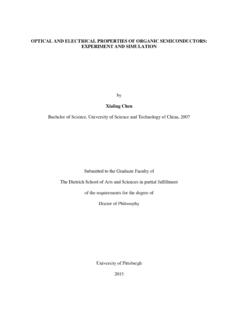Transcription of SOLID STATE PHYSICS PART II Optical Properties of Solids
1 SOLIDSTATEPHYSICSPART IIOpticalPropertiesofSolidsM. S. DresselhausiContents1 Reviewof Fundamental Relationsfor OpticalProbes .. the complexopticalconductivity .. ComplexDielectricFunctionto Observables.. FrequencyMeasurements ..72 DrudeTheory{Free CarrierContributionto the CarrierContribution.. FrequencyResponse:! 1 .. ;! 1 .. 113 .. the Hamiltonianin an ElectromagneticField.. MomentumMatrixElements and the E ective Mass.. Solids .. 234 TheJoint Density of Statesand Density of States.. 305 Absorptionof Light in cient .. CarrierAbsorptionin Semiconductors.. CarrierAbsorptionin Metals.. the AbsorptionEdgeon FermiEnergy.. the AbsorptionEdgeon AppliedElectricField.. CrystalMomentumin DirectOpticalTransitions.}
2 51ii6 OpticalPropertiesof SolidsOver a {KronigRelations.. BandStructure.. ectivity Experiments .. Measurement of OpticalConstants .. 717 Impuritiesand Level Spectroscopy .. Impurity Levels .. HydrogenicModel.. ,ColorCenters and Interstitials.. of Excitons.. cationof Excitons.. QuantumWell Structures.. 938 Luminescenceand cationof LuminescenceProcesses.. Absorption.. 10910 OpticalStudyof Semiconductors.. and Polarizability .. Scattering.. Light Scattering.. QuantumWells and Superlattices.. 13311 .. 14112 ElectronSpectroscopy and .. PhotoelectronSpectroscopy .. raction.. , EELS.. (AES).. 16413 .. AmorphousSemiconductors.. Properties .. AmorphousSemiconductors.}
3 183A TimeDependent .. 2nd OrderPerturbationTheory.. 191B HarmonicOscillators,Phonons,and the .. 3D Crystals.. 199C OrganicMaterialsfor SolidStateDevices202ivChapter1 Reviewof Fundamental Relationsfor OpticalPhenomenaReferences: G. Beke and ,ElectromagneticVibrationsWavesand Radiation, MITP ress,Cambridge,MA ,Classical Electrodynamics, Wiley, NewYork,1975 Bassaniand Pastori{Parravicini,ElectronicStatesand Optical Transitionsin Solids ,PergamonPress,NY (1975). Yu and Cardona,Fundamentals of Semiconductors,SpringerVerlag(1996) OpticalProbesTheopticalpropertiesof solidsprovidean important tool for studyingenergybandstruc-ture,impurity levels, excitons,localizeddefects,latticevibrati ons, such experiments, we measuresomeobservable,such as re ectivity, trans-mission,absorption,ellipsometryor light scattering;fromthesemeasurements we deducethe dielectricfunction"(!)}
4 , the opticalconductivity (!), or the fundamental is the frequency-dependent complexdielectricfunction"(!) or the complexconductivity (!), which is directlyrelatedto the energybandstructureof the relationshipbetween experimental observationsandtheelectronicenergylevels (energybands)of the the infraredphotonenergyregion,informationon the phononbranches is the major concernofPart II of this Complexdielectricfunctionand the complexopticalconductivityThecomplexdiel ectricfunctionand complexopticalconductivity are introducedthroughMaxwell'sequations( )r ~H 1c@~D@t=4 c~j( )r ~E+1c@~B@t= 0( )r ~D= 0( )r ~B= 0( )wherewe have assumedthatthe chargedensity is equationsare writtenas:~D="~E( )~B= ~H( )~j= ~E( ) de nesthe quantity"fromwhich the conceptof the complexdielectricfunc-tionwill be developed.
5 Whenwe discussnon{linearoptics(seeChapter11),th eselinearconstitutive equations( { )must be generalizedto includehigherordertermsin~E~Eand~E~E~E. FromMaxwell's equationsand the constitutive equations,we obtaina waveequationfor the eldvariables~Eand~H:r2~E=" c2@2~E@t2+4 c2@ c2@2~H@t2+4 c2@ Optical elds,we must look for a sinusoidalsolutionto and ~E=~E0ei(~K ~r !t)( )where~Kis a complexpropagationconstant and!is the frequencyof the light. A solutionsimilarto Eq. obtainedfor the~H ~Kcan be identi edas awave vector,whilethe imaginarypartof~Kaccounts for attenuationof the wave the planewave solutionEq. the wave equationEq. yieldsthe followingrelationforK: K2= " !2c2 4 i !c2:( )If therewere no losses(or attenuation),Kwouldbe equaltoK0=!}}
6 Cp" ( )2and wouldbe real,but sincethereare losseswe writeK=!cp"complex ( )wherewe have de nedthe complexdielectricfunctionas"complex="+4 i !="1+i"2:( )As shown in Eq. is customaryto write"1and"2for the real and imaginarypartsof"complex. Fromthe de nitionin Eq. alsofollows that"complex=4 i! +"!4 i =4 i! complex;( )wherewe de nethe complexconductivity complexas: complex= +"!4 i( )Now thatwe have de nedthe complexdielectricfunction"complexandthe complexconductivity complex, we will relatethesequantitiesin two ways:1. to observablessuch as the re ectivity which we measurein the laboratory,2. to propertiesof the solidsuch as the carrierdensity, relaxationtime,e ective masses,energybandgaps, Eq. ,the solutionEq. the wave equation( )yieldsa planewave~E(z; t) =~E0e i!
7 Texp0@i!zcp" s1 +4 i "!1A:( )For the wave propagatingin vacuum("= 1, = 1, = 0), Eq. a simpleplanewave solution,whileif the wave is propagatingin a mediumof niteelectricalconductivity,the amplitudeof the wave exponentiallydecays over a characteristicdistance given by =c!~N2(!)=c!~k(!)( )where is calledthe opticalskindepth,and~kis the imaginarypartof the complexindexof refraction(alsocalledthe extinctioncoe cient)~N(!) =p "complex=s" 1 +4 i "! = ~n(!) +i~k(!):( )Thismeansthattheintensityof the electric eld,jEj2, fallso to 1=eof its valueat thesurfacein a distance1 abs=c2!~k(!)( )3where abs(!) is the absorptioncoe cient for the solidat frequency!.Sincelight is described by a transversewave, thereare two possibleorthogonaldirec-tionsfor the~Evectorin a planenormalto the propagationdirectionand thesedirectionsdeterminethepolarizationo f the light.
8 For cubicmaterials,the indexof refractionis thesamealongthe two , for anisotropicmedia,the indicesofrefractionmay be di erent for the two polarizationdirections,as is ComplexDielectricFunctionto ObservablesIn relating"complexand complexto the observables,it is convenient to introducea complexindexof refraction~Ncomplex~Ncomplex=p "complex( )whereK=!c~Ncomplex( )and where~Ncomplexis usuallywrittenin termsof its real and imaginaryparts(see Eq. )~Ncomplex= ~n+i~k=~N1+i~N2:( )Thequantities~nand~kare collectively calledthe opticalconstantsof the SOLID ,where~nis the indexof refractionand~kis the extinctioncoe cient. (We use the tildeover theopticalconstants ~nand~kto distinguishthemfromthe carrierdensity and wave vectorwhichare denotedbynandk). Theextinctioncoe cient~kvanishesfor ,we can take = 1, and this will be donein writingthe de nitionfor~Ncomplex, we can relate"complex="1+i"2= (~n+i~k)2( )yieldingthe important relations"1= ~n2 ~k2( )"2= 2~n~k( )wherewe notethat"1; "2;~nand~kare all measurements of the opticalpropertiesof solidsinvolve the normalincidencere ectivity which is illustratedin Fig.
9 SOLID ,the wave will be assumefor the present discussionthatthe solidis thick enoughso thatre ectionsfromthe back surfacecan be can thenwritethe wave insidethe solidfor thisone-dimensionalpropagationproblemasE x=E0ei(Kz !t)( )wherethe complexpropagationconstant for the light is given byK= (!=c)~ the otherhand,in free spacewe have both an incident and a re ectedwave:Ex=E1ei(!zc !t)+E2ei( !zc !t):( ) : Schematicdiagramfor normalincidencere ,the continuity ofExacrossthe surfaceof the solidrequiresthatE0=E1+E2:( )With~Ein thexdirection,the secondrelationbetweenE0; E1;andE2follows fromthecontinuity conditionfor tangentialHyacrossthe boundaryof the 'sequation( ) we haver ~E= c@~H@t=i !c~H( )which resultsin@Ex@z=i !cHy:( )Thecontinuity conditiononHythus yieldsa continuity relationfor@Ex=@zso thatfromEq.
10 !c E2!c=E0!c~Ncomplex( )orE1 E2=E0~Ncomplex:( )Thenormalincidencere ectivityRis thenwrittenasR= E2E1 2( )which is mostconveniently relatedto the re ectioncoe cientrgiven byr=E2E1:( ) ,we have the resultsE2=12E0(1 ~Ncomplex)( )E1=12E0(1 +~Ncomplex)( )so thatthe normalincidencere ectivity becomesR= 1 ~Ncomplex1 +~Ncomplex 2=(1 ~n)2+~k2(1 + ~n)2+~k2( )and the re ectioncoe cient for the wave itselfis given byr=1 ~n i~k1 + ~n+i~k( )wherethe re ectivityRis a number less thanunity andrhas an amplitudeof less thanunity. We have now relatedone of the physicalobservablesto the opticalconstants. Torelatetheseresultsto the power absorbed and transmittedat normalincidence,we utilizethe followingrelationwhich expressesthe ideathatall the incident power is eitherre ected,absorbed, or transmitted1 =R+A+T( )whereR,A, andTare, respectively, the fractionof the power thatis re ected,absorbed, andtransmittedas illustratedin Fig.



















